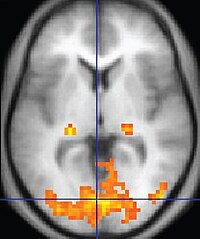
Photo from wikipedia
Objective: There may be a need to perform dynamic skull aberration corrections during the non-invasive high-intensity transcranial treatment with magnetic resonance imaging (MRI) -guided focused ultrasound in order to accurately… Click to show full abstract
Objective: There may be a need to perform dynamic skull aberration corrections during the non-invasive high-intensity transcranial treatment with magnetic resonance imaging (MRI) -guided focused ultrasound in order to accurately and rapidly restore the focus in the brain. Methods: This could possibly be accomplished by using an ultrasound-based correction method based on the skulls’ thickness resonance frequencies. The focus of a 500 kHz transducer was centered in the ex vivo human skull caps at different temperatures. The pulse-echoed signals reflected from the skulls were analyzed in the frequency domain to reveal the resonance frequencies for the phase shift calculation. The accuracy was compared to both hydrophone and computed tomography (CT) based analytical methods. Results: Around 73% of the measurements (n = 784) were in the optimal constructive interference region, with a 15° decrease in the average phase error compared to the previous study. In the best implementation, it performed approximately the same or better than the CT based analytical method currently in clinical use. Linear correlation was found between the resonance frequencies or skull induced phase shifts and the skull temperature with an average rate of −0.4 kHz/°C and 2.6 deg/°C, respectively. Conclusion: The ultrasound based resonance method has shown the feasibility of detecting heating-induced changes of skull phase shift non-invasively and accurately. Significance: Since the technique can be made MRI compatible and integrated in the therapy arrays, it may enable temperature tracking and adaptive focusing during high-intensity transcranial ultrasound treatments, to prevent skull overheating and preserve the transcranial focusing integrity.
Journal Title: IEEE Transactions on Biomedical Engineering
Year Published: 2020
Link to full text (if available)
Share on Social Media: Sign Up to like & get
recommendations!